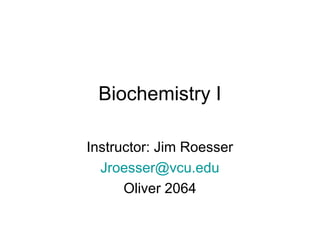
Jr chapter 1
- 1. Biochemistry I Instructor: Jim Roesser Jroesser@vcu.edu Oliver 2064
- 2. Administrative stuff 1. Syllabus 2. About different editions of the book/used books
- 3. Why are you taking this course? A. Required for my major B. Required for medical/professional school C. General interest
- 5. Why is biochemistry important Agriculture Medicine History Forensic Science
- 10. Fig. 1-08d, p.9
- 11. Fig. 1-08e, p.9
- 12. Fig. 1-08f, p.9
- 13. Fig. 1-08g, p.9
- 14. Table 1-2, p.8
- 16. Biological Macromolecules • Proteins • Nucleic Acids • Carbohydrates • Lipids
- 17. Fig. 1-09a, p.12
- 18. Fig. 1-09c, p.12
- 19. Fig. 1-09b, p.12
- 20. Fig. 1-10, p.12
- 22. Table 1-3, p.13
- 23. Fig. 1-14a, p.15
- 24. Fig. 1-14b, p.15
- 25. Fig. 1-15a, p.16
- 26. Fig. 1-15b, p.16
- 27. Fig. 1-15c, p.16
- 29. Fig. 1-20, p.21
- 30. Fig. 1-16c, p.17
- 31. Fig. 1-16a, p.17
- 32. Fig. 1-16b, p.17
- 33. Water and its properties
Notes de l'éditeur
- Figure 1.8 Molecular organization in the cell is a hierarchy.
- Figure 1.8 Molecular organization in the cell is a hierarchy.
- Figure 1.8 Molecular organization in the cell is a hierarchy.
- Figure 1.8 Molecular organization in the cell is a hierarchy.
- Figure 1.8 Molecular organization in the cell is a hierarchy.
- Figure 1.8 Molecular organization in the cell is a hierarchy.
- Figure 1.8 Molecular organization in the cell is a hierarchy.
- Active Figure 1.9 (a) Amino acids build proteins by connecting the _-carboxyl C atom of one amino acid to the _-amino N atom of the next amino acid in line.
- (c) Nucleic acids are polymers of nucleotides linked by bonds between the 3_-OH of the ribose ring of one nucleotide to the 5_-PO4 of its neighboring nucleotide. All three of these polymerization processes involve bond formations accompanied by the elimination of water (dehydration synthesis reactions). Test yourself on the concepts in this at http://chemistry.brookscole.com/ggb3
- (b) Polysaccharides are built by combining the C-1 of one sugar to the C-4 O of the next sugar in the polymer.
- Active Figure 1.10 The sequence of monomeric units in a biological polymer has the potential to contain information if the diversity and order of the units are not overly simple or repetitive. Nucleic acids and proteins are information-rich molecules; polysaccharides are not. Test yourself on the concepts in this at http://chemistry.brookscole.com/ggb3
- Animated Figure 1.14 Some of the biologically important H bonds and functional groups that serve as H bond donors and acceptors. See this animated at http:// chemistry.brookscole.com/ggb3
- Animated Figure 1.14 Some of the biologically important H bonds and functional groups that serve as H bond donors and acceptors. See this animated at http:// chemistry.brookscole.com/ggb3
- Ionic bonds in biological molecules.
- Ionic bonds in biological molecules.
- Ionic bonds in biological molecules.
- Animated Figure 1.20 Reproduction of a metabolic map. (Source: Donald Nicholson’s Metabolic Map #21. Copyright © International Union of Biochemistry and Molecular Biology. Used with permission.) See this animated at http://chemistry.brookscole.com/ggb3
- Structural complementarity: the pieces of a puzzle.
- (a) The antigen on the right (green) is a small protein, lysozyme, from hen egg white. The part of the antibody molecule (IgG) shown on the left in blue and yellow includes the antigen-binding domain.
- (b) This domain has a pocket that is structurally complementary to a surface protuberance (Gln121, shown in red between antigen and antigen-binding domain) on the antigen.